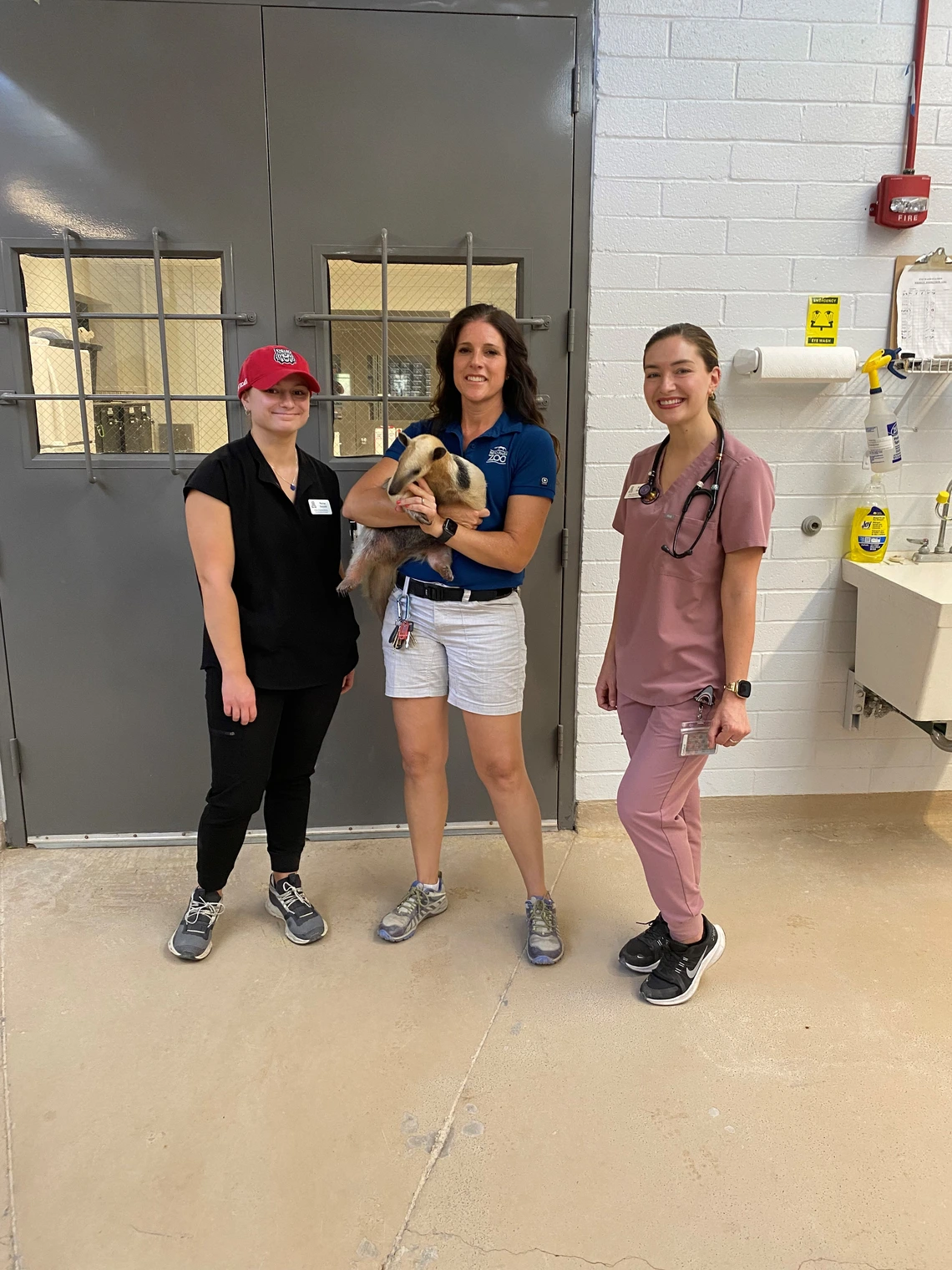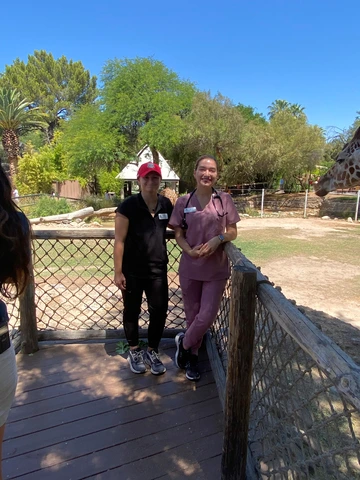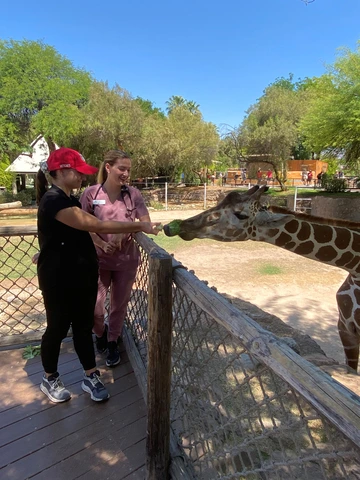VetCats at Reid Park Zoo
Reid Park Zoo, an AZA-accredited zoo, is partnering with the University of Arizona College of Veterinary Medicine to provide Doctor of Veterinary Medicine students a unique opportunity to learn and practice zoo medicine.

Reid Park Zoo, an AZA-accredited zoo, is partnering with the University of Arizona College of Veterinary Medicine to provide Doctor of Veterinary Medicine students a unique opportunity to learn and practice zoo medicine. Equipped with a teaching hospital, Reid Park Zoo offers countless educational opportunities. From summer camps to clinical opportunities, Reid Park’s commitment to education makes them an ideal place for veterinary students to gain exposure to zoo medicine, refine key skills, and learn how to educate future generations about animal conservation.

Zoo medicine is a competitive field—the earlier students can gain practical field experience, the better their prospects for entering the profession. CVM students enjoy hands-on outlets to explore their passion for zoo medicine through our partnership with Reid Park Zoo, which offers students clinical year electives onsite. In addition, student groups, such as Arizona's Zoo, Exotics, Wildlife, and Avian Club (ZEWAC), regularly shadow during daily veterinary care routines and offer sign-up options for curious students. Opportunities to gain exposure to zoo medicine are invaluable to our students, who have the incredible opportunity of learning from Reid Park's head veterinarian, Dr. Alexis Roth.
Like many of our students, Dr. Roth knew from a young age that she wanted to be a veterinarian. After obtaining her Doctor of Veterinary Medicine from Colorado State University and interning at Busch Gardens in Florida, Roth's passion for zoo medicine eventually landed her at Reid Park in her hometown of Tucson, where she has worked for over 15 years. Roth believes there is nothing like the wonder of working with animals. She shared,
"What I like about zoo medicine and what drove me to [it] in general is that it's always a challenge. It's always different. First thing in the morning, I may [start by] working with an elephant, then I might next move on to a giraffe and then hand-syringe a lion. It's the challenge of thinking outside the box about how to work with these animals, but also about the humility of doing so. It is a privilege to be able to stand beneath a 13,000-pound bull elephant and just experience what that feels like. Very few people get that opportunity. So every day is a grateful one for me."
Student shadowing provides a controlled environment for them to acquire an accurate picture of the unique atmosphere that working with exotic animals affords. For Dr. Roth, a typical day at the zoo begins with early morning check-ins on any reported health concerns or ongoing medical conditions, such as age-related complications or hereditary issues. After providing detailed attention to high-risk cases, Dr. Roth completes her rounds by ensuring each animal has received a visit, sometimes accompanied by our CVM students. Daily health checks allow zoo veterinarians to get to know each animal's unique personality and needs, making it easier to track animals' health. Students who attend and participate in daily rounds acquire first-hand experience in the diversity of tasks a zoo veterinarian faces and gain a realistic picture of a possible future career in action.
An enterprising and dynamic veterinarian, Dr. Roth shares her extensive medical insight with students, but not before asking them their own opinions. Knowing that the best way to learn is by doing, Dr. Roth expects her shadowing students to form opinions and offer insight based on their knowledge. She shared, "I ask the students to have an opinion on [animals' health]. I will not just regurgitate what I know because with veterinary medicine, and medicine in general, you learn by doing it yourself with supervision." When students encounter new situations at the zoo, Dr. Roth asks them to research, enabling them to become effective problem solvers who can find well-reasoned solutions. This invaluable experience reflects the reality of zoo medicine: a veterinarian will not know all the answers immediately but must know where to look to discover solutions. Choosing to be an effective problem-solver when treating exotic animals can mean finding resources in specialized books or consulting with other zoo vets around the world. A vast network of other experts in the field helps zoo practitioners find resolutions for atypical medical situations and easily collaborate by sharing valuable insight that can enhance veterinary medical care worldwide. CVM students planning to join this network of professionals have the privilege of observing Dr. Roth's problem-solving acumen and professional toolkit for dealing with unexpected situations.
Beginning in August, the College of Veterinary Medicine's class of 2023 begins clinical rotations, a vital step toward becoming day-one-ready veterinarians. Students passionate about zoo medicine will have the opportunity to spend one of their eight four-week elective rotations working alongside Dr. Roth and practicing crucial skills necessary for managing zoo animal care. Clinical rotations offer a deeper-dive experience in exotic animal medicine than shadowing opportunities. This experiential learning allows future veterinarians insight into possible career paths and enhances the potential for future zoo internships or externships. Students must be ready to roll their sleeves up and put their training into action. Dr. Roth shared,

"I'm an adjunct professor. So I'll have veterinary students that rotate through officially as part of their program. What they do will probably be similar to [the shadowing opportunity] we're doing right now, but they will have a more regimented curriculum, so it'll be like, 'today we're going to learn about the GI tract.' So they will learn it, but we'll do it in an elephant, or we'll do it in a rhino, or a squirrel monkey or something like that. If there are surgeries, which there will be, then the students will be a part of that."
Because it is vital to gain zoo medical experience before entering the field, Dr. Roth offered some valuable advice for students interested in zoo medicine, stating,
"Persistence and experience [are the most important things a future zoo veterinarian can have]. The more skillsets you have in your pocket, the better veterinarian you're going to be. I encourage students to go on their free time and be a veterinary technician and learn how to put an IV catheter and learn how to draw blood because that's what they're asking me to do when I go out in the field here."
CVM students will put these key skills and more into action in their clinical rotations at Reid Park and attain a thorough proficiency in the practice of zoo medicine. As they work, they will develop a rich appreciation of how zoos partner with communities to provide vital educational and conservation resources to serve our animal populations. Unique in its variety and challenges, zoo medicine requires dedicated, resourceful professionals. Our partnership with Reid Park Zoo enriches our excellent veterinary medical education and helps prepare the next generation of zoo medical practitioners to become the committed, community-minded professionals who will lead the education and conservation efforts championed by zoos.
